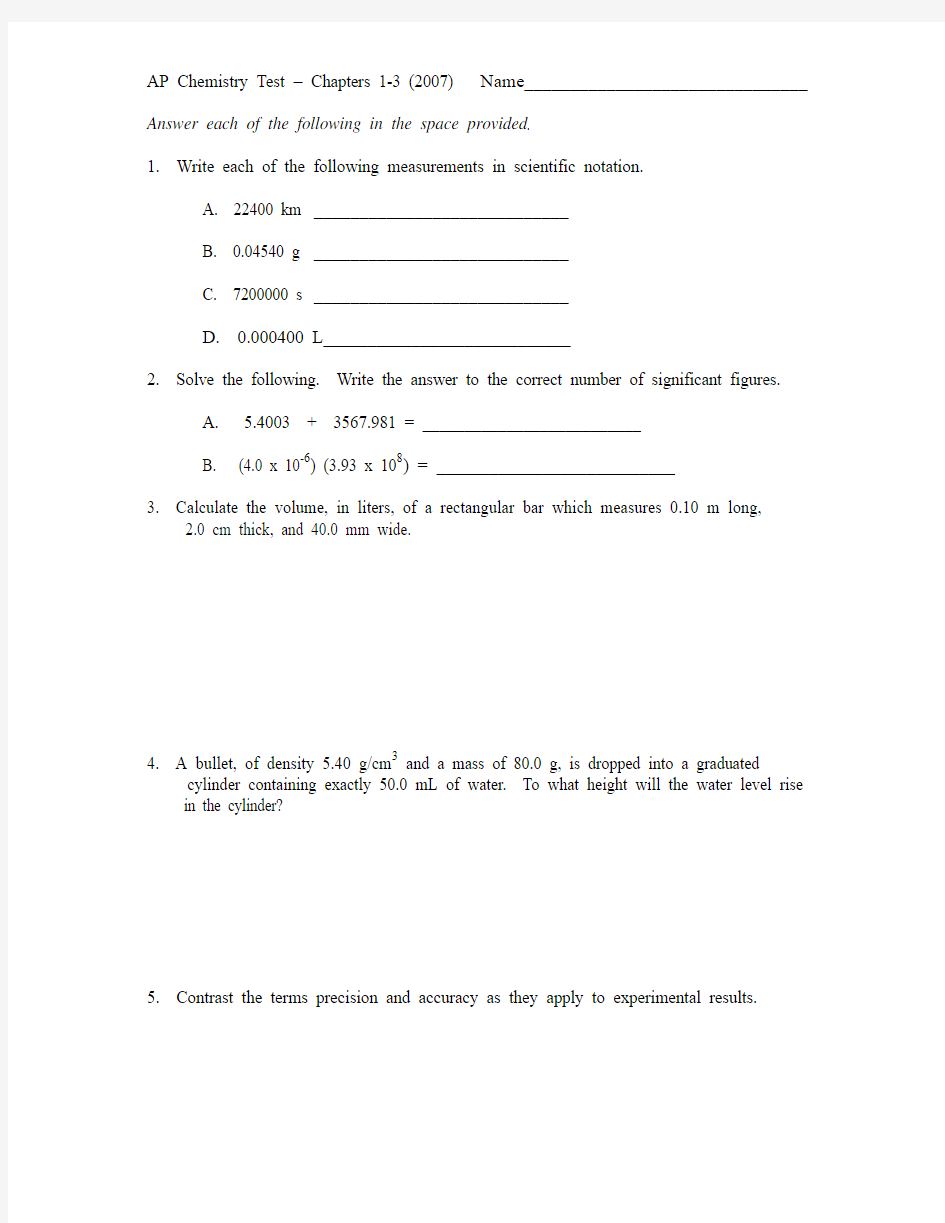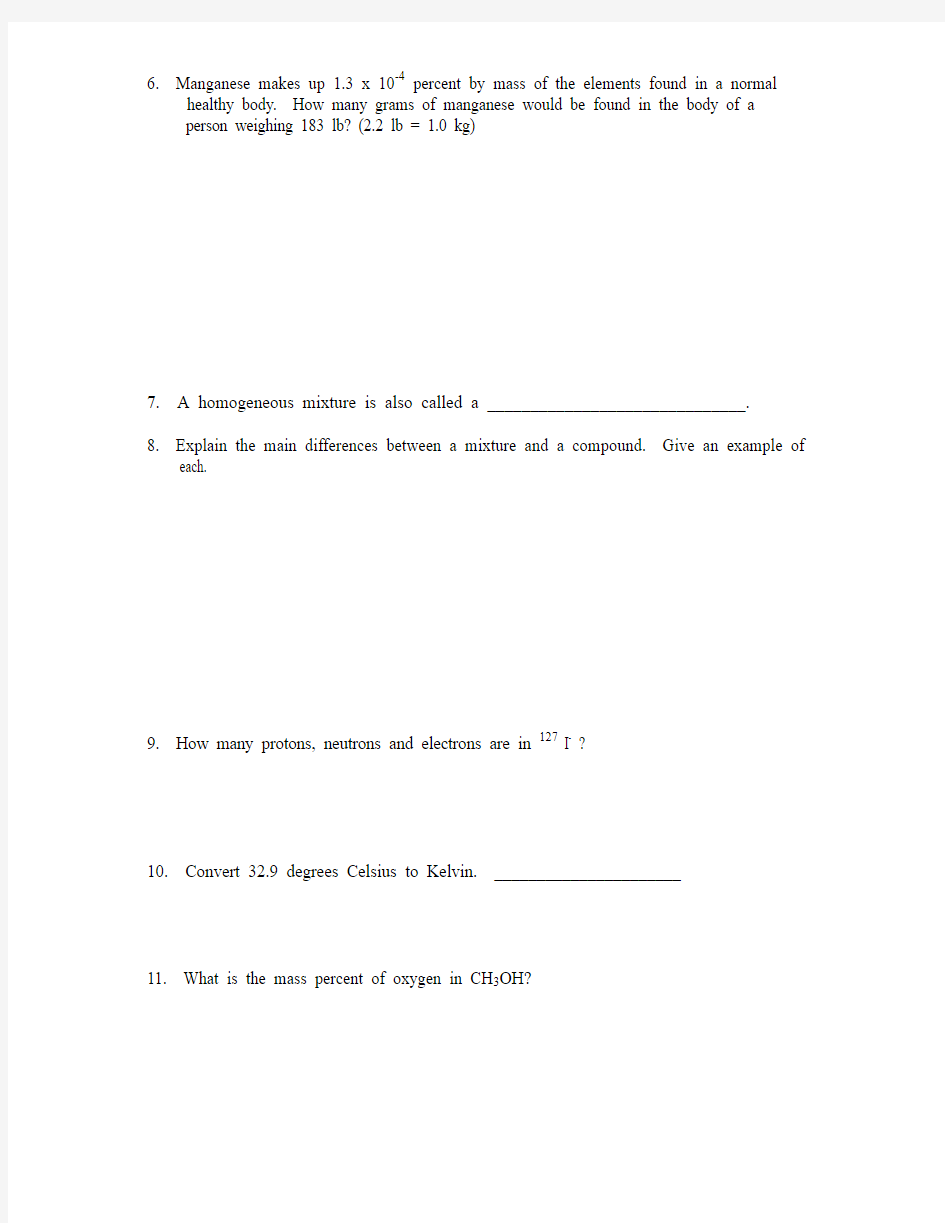AP Chemistry Test – Chapters 1-3


AP Chemistry Test – Chapters 1-3 (2007) Name_______________________________ Answer each of the following in the space provided.
1. Write each of the following measurements in scientific notation.
A. 22400 km ____________________________
B. 0.04540 g ____________________________
C. 7200000 s ____________________________
D. 0.000400 L____________________________
2. Solve the following. Write the answer to the correct number of significant figures.
A. 5.4003 + 3567.981 = __________________________
B. (4.0 x 10-6) (3.93 x 108) = ___________________________
3. Calculate the volume, in liters, of a rectangular bar which measures 0.10 m long,
2.0 cm thick, and 40.0 mm wide.
4. A bullet, of density
5.40 g/cm3 and a mass of 80.0 g, is dropped into a graduated
cylinder containing exactly 50.0 mL of water. To what height will the water level rise in the cylinder?
5. Contrast the terms precision and accuracy as they apply to experimental results.
6. Manganese makes up 1.3 x 10-4 percent by mass of the elements found in a normal
healthy body. How many grams of manganese would be found in the body of a
person weighing 183 lb? (2.2 lb = 1.0 kg)
7. A homogeneous mixture is also called a ______________________________.
8. Explain the main differences between a mixture and a compound. Give an example of each.
9. How many protons, neutrons and electrons are in 127 I- ?
10. Convert 32.9 degrees Celsius to Kelvin. ______________________
11. What is the mass percent of oxygen in CH3OH?
12. Naturally occurring argon has three isotopes, the atoms of which occur in the
following abundances: 0.34% 36Ar, 0.07% 38Ar, 99.59% 40Ar. Calculate the
average atomic weight of argon from these data.
13. A sample of ammonia (NH3) has a mass of 56.6 grams. How many molecules are in the sample?
14. What is the mass of one atom of copper in grams?
15. A. A substance contains 35.0 g nitrogen, 5.05 g of hydrogen, and 60.0 g of oxygen. How many grams of hydrogen are there in a 185 g sample of the substance?
B. What fundamental law of chemistry did you apply to answer part A?
16. Match each scientist to his accomplishment.
_____Antoine Lavoisier A. solid sphere model of the atom
_____Amadeo Avogadro B. measured the relationship between pressure and
volume of gases
_____Robert Millikan C. nuclear model of the atom
_____Robert Boyle D. verified the law of conservation of mass
_____John Dalton E. suspended oil drops to determine the mass of an
electron
_____Ernest Rutherford F. proposed that at the same temperature and
pressure, equal volumes of different gases
contain the same number of molecules
17. Name the following compounds.
a. H2O2_________________________
b. Pb(C2H3O2)2 _____________________________________
c. Hg2F2_________________________
d. NaHSO4_________________________
e. H3PO4_________________________
f. Al(NO2)3_________________________
g. K2Cr2O7_________________________
h. N2O5 _________________________
18. Write the formula for the following compounds.
a. ammonium hydroxide _________________________
b. hydrosulfuric acid _________________________
c. potassium permanganate _________________________
d. cesium perchlorate _________________________
e. nitrous acid _________________________
f. lead (IV) sulfide _________________________
g. sodium cyanide _________________________
